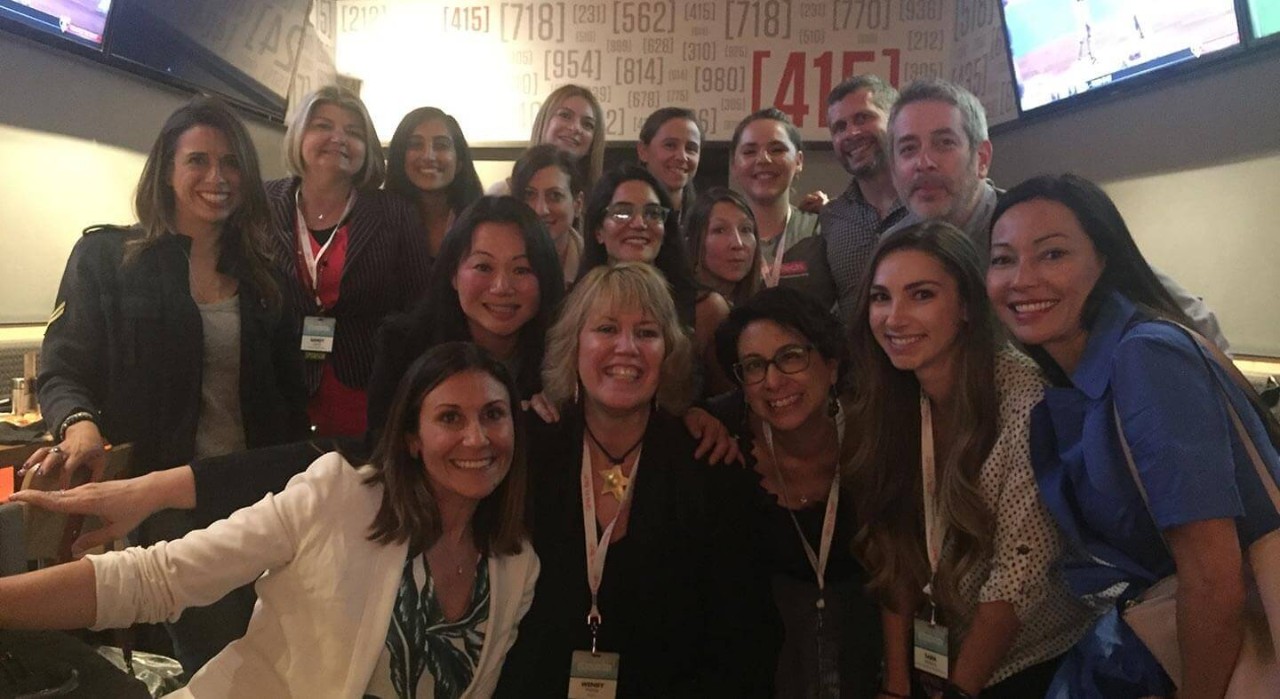When NASA asked for ideas to improve cockpit displays for the not-yet-launched space shuttle program in a 1980s magazine ad, one 16-year-old high school junior took notice.
Aerospace engineers sought a design that would enable shuttle pilots to gauge the location of other air traffic as they reentered the atmosphere at incredibly high speeds and prepared to land. Wendy’s solution granted her an opportunity to work at NASA’s Ames Research Center, which deeply concerned her parents.
“I got permission to leave school and work there one day a week,” she said. “In exchange, my parents asked me to attend secretarial school so that I would have some sort of viable career to fall back on. Back then, it was fairly obvious that girls couldn’t have careers in science or math.”
 Wendy gives her high school valedictorian speech.
Wendy gives her high school valedictorian speech.
That was the 1980s. Fast forward to today and Pfeiffer is CIO at Nutanix, an industry leader in enterprise cloud computing. It follows leadership roles at Cisco, Yahoo! and GoPro.
She was selected as one of HMG’s 2019 Top Technology Executives to Watch, ranked first on Enterprise Management 360’s 2018 list of Top 10 Tech CIOs Who Inspire and Influence Us, named one of Silicon Valley Business Journal’s 2018 Women of Influence and listed as one of the National Diversity Council’s 2018 Top 50 Most Powerful Women in Technology.
Plus, she can still type more than 100 words per minute.
Hooked on Computing
A fifth-generation Californian born and raised in Silicon Valley when it was called the Valley of Heart’s Delight, Pfeiffer remembers walking to school through apricot orchards before the IBM complex was built. She feels California in her bones and loves its agricultural roots and quest for technology innovation.
Pfeiffer says the NASA internship solidified her interest in cutting edge technologies and, in particular, large-scale computer systems. As the tech bubble inflated, burst and grew again, she built a reputation for helping large companies like Cisco and Yahoo! adopt the transformative technologies they were selling others. She made sure they were “drinking their own champagne.”
“I learned that I was passionate about helping companies take advantage of their own disruption,” Pfeiffer said. That’s exactly what she’s doing at Nutanix, a pioneer of hyperconverged infrastructure (HCI) technology that has become an industry leader in enterprise cloud computing.
She made sure her company’s digital operations were powered by best of breed products like the Nutanix Acropolis operating system (AOS) with AHV for enterprise virtualization to function in a multi-cloud world, and Nutanix Files (AFS) for scalable storage.

“We have some of the best IT operational metrics in the industry,” she said. “We have lean staffing, a Net Promoter Score in the 90s, 100% availability for our systems, all while the company is growing exponentially.”
She said running Nutanix software is allowing her team to begin adopting machine learning (ML) and natural language processing (NLP).
Crocodile Amongst Dinosaurs
Pfeiffer also constantly rolls out new products and test-drives them internally. The CIO expresses frustration with enterprise IT vendors, who, she said, seem to spend more time looking to the past than to the future.
“About 70% of the resources of enterprise IT is expended on activities that are called KTLO, Keep The Lights On, activities,” Pfeiffer said. “That’s a lot of effort to keep the old systems up and running, which means we never have the mental, emotional or physical bandwidth to design and think through anything new.”
While consumer technologies have become more and more sophisticated, IT managers often make “safe” choices that preclude the same level of disruption and consumer satisfaction.
“It’s an abject failure of enterprise IT vendors, to fail to recognize how consumer technology has completely, profoundly leap-frogged them,” said Pfeiffer. “But, also, it is a failure on the part of me and my peers, that we don’t demand better, that we continue to make the safe choices.”
IT leaders also need to modernize the way that we staff our positions. “We need to redefine our roles, how we search for and find people for those roles, and even the models of employment themselves.”
She sees Nutanix as a bridge to get people out of the old mode and untied from technology choices made over the past two decades. “My work with Nutanix is about the survival and progression of IT,” she said. “It’s enabling IT to thrive like the crocodile.”
Building a Talent Pool for Disruption
Pfeiffer looks for talent in a variety of underrepresented populations. She is on the board of Girls in Tech (GIT), a global non-profit that works to eradicate gender inequality in the field by educating and empowering women to pursue jobs in high-tech industries and startups. Active in more than 30 countries, the organization offers everything from coding courses to bootcamps and hackathons and startup competitions regardless of age or profession.
 Wendy with the Girls in Tech board of directors.
Wendy with the Girls in Tech board of directors.
“The typical person who benefits from Girls in Tech might be a female who had her educational trajectory derailed in some way,” said Pfeiffer. “Maybe she is from a poor family and had to be married early in order to give the dowry to the family. Or maybe she is a single mom in the U.S. and had to work a couple of jobs and just got that high school GED.”
Another untapped group is the Veteran community. Wendy remembers the frustration she felt after reading an article in the East Bay Times about a U.S. Army veteran who had returned from Desert Storm and used his military benefits to get an education, including earning several tech certifications. Yet, after two years of looking, he couldn’t find a job.
“At the time, I had just come from Yahoo!, which bought Hot Jobs,” said Pfeiffer. “I was really aware of the algorithms that we used in order to sift through resumes and find candidates. I connected with this guy and asked to see his resume. Of course, his resume had all of these words that our search bots weren’t looking for.”
Recognizing the disconnect, Pfeiffer worked with leaders at her then-employer Robert Half, to begin working with veterans’ organizations, including NPower and From Swords to Plowshares, which provide training and support for military veterans to obtain careers in the tech sector. Together, they worked to translate these disparate languages to bridge the divide.
Pfeiffer sees irony in companies that hesitate to hire vets with proven abilities to show up, get trained, serve and excel in extreme environments.
“If they managed in life-and-death situations, 24 hours a day, a complex system, I think they’re going to be able to learn Windows or how to automate,” she said. “As a global society, we have a responsibility to employ these people.”
 Wendy M. Pfeiffer with her family volunteering at Kids Against Hunger.
Wendy M. Pfeiffer with her family volunteering at Kids Against Hunger.
Married to a professional musician who worked a day job at Sun Microsystems for years while raising their son and daughter (now teens), Pfeiffer recognizes the benefits for teams that take advantage of diverse thought processes and skills.
“If we hope to attract a diverse workforce, which is necessary for us to create products that hold their own with other sophisticated technologies, then we cannot create job descriptions that put people in a box or in a cubicle, and say, ‘Your job is to develop software. It’s not to write music, teach classes or make art,’” she said.
In fact, Pfeiffer argues that these other creative skills, combined with passion and a knack for solving problems – skills she says might typically be considered “entrepreneurial skills” – are exactly what’s needed throughout the industry right now.
“There are scores of incredibly creative young people, or older people just starting out in a new career area, who have contributions to make, but they need to work in synergistic teams. They need to bring their unique contributions,” she said. “And we need to have a way of identifying them and bringing them in, and then create organizational structures and technical structures that enable them to create and collaborate and extend.”
Joyce Riha Linik is a contributing writer. Find her on Twitter @JoyceRihaLinik.
© 2019 Nutanix, Inc. All rights reserved. For additional legal information, please go here.
